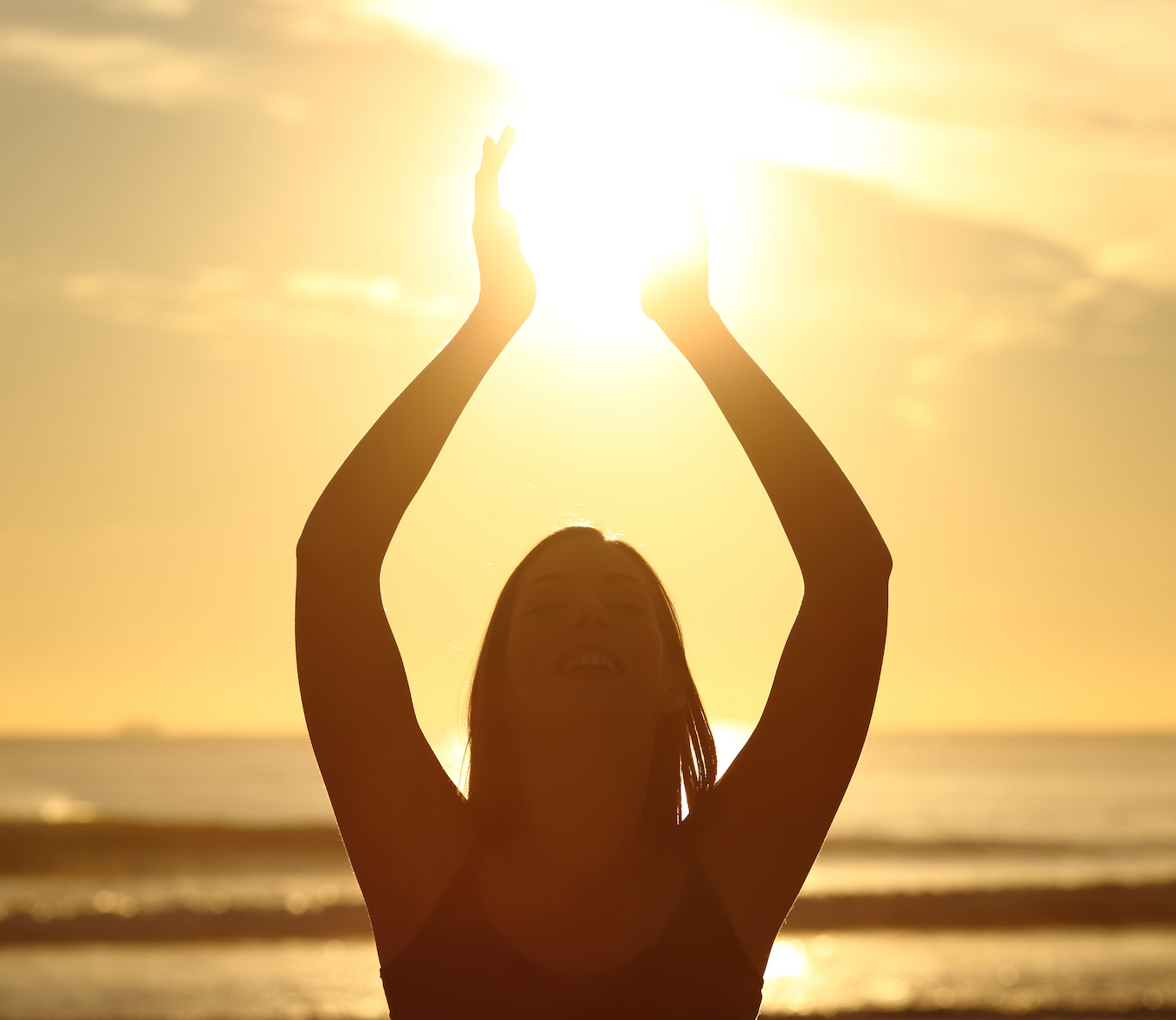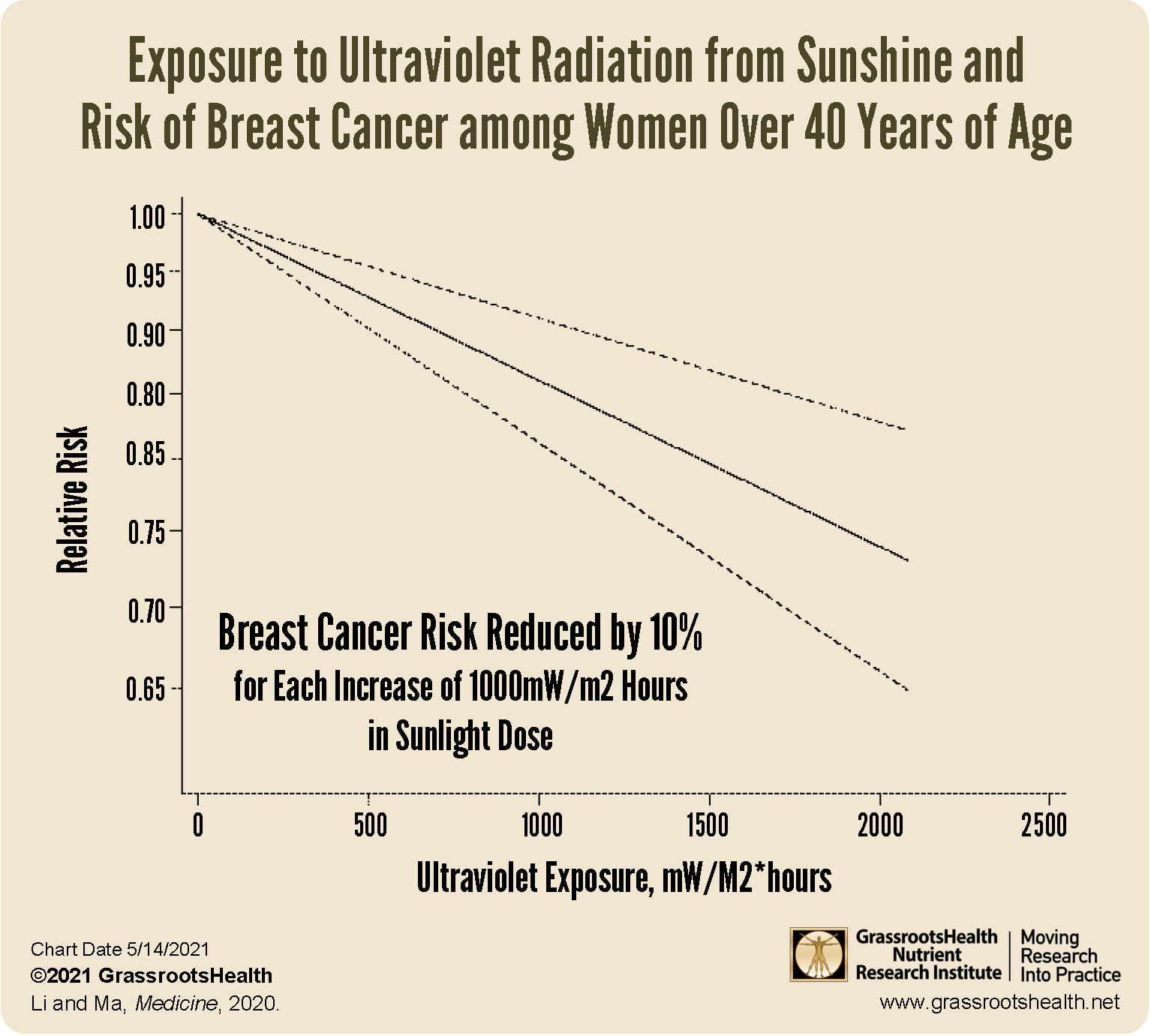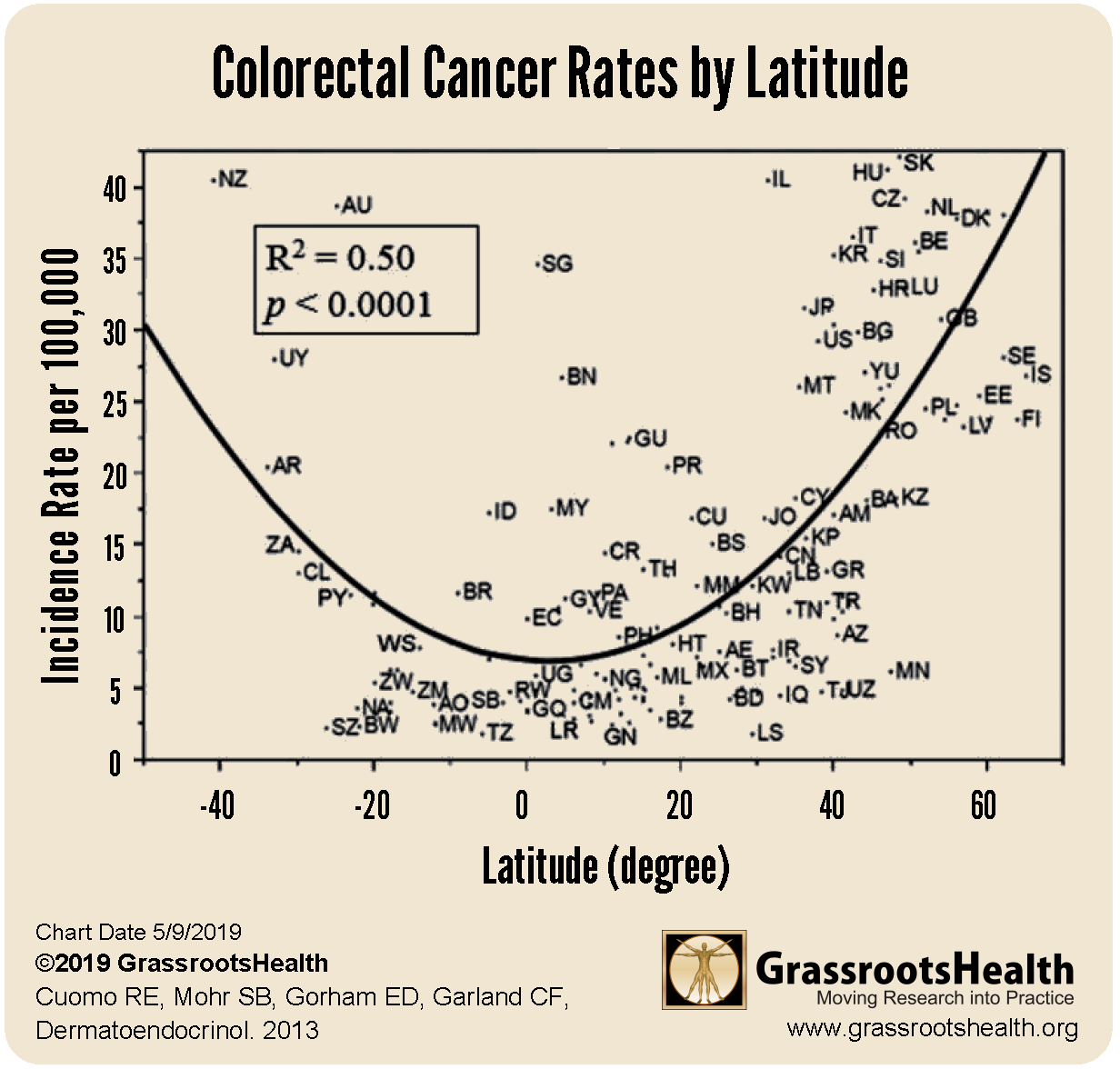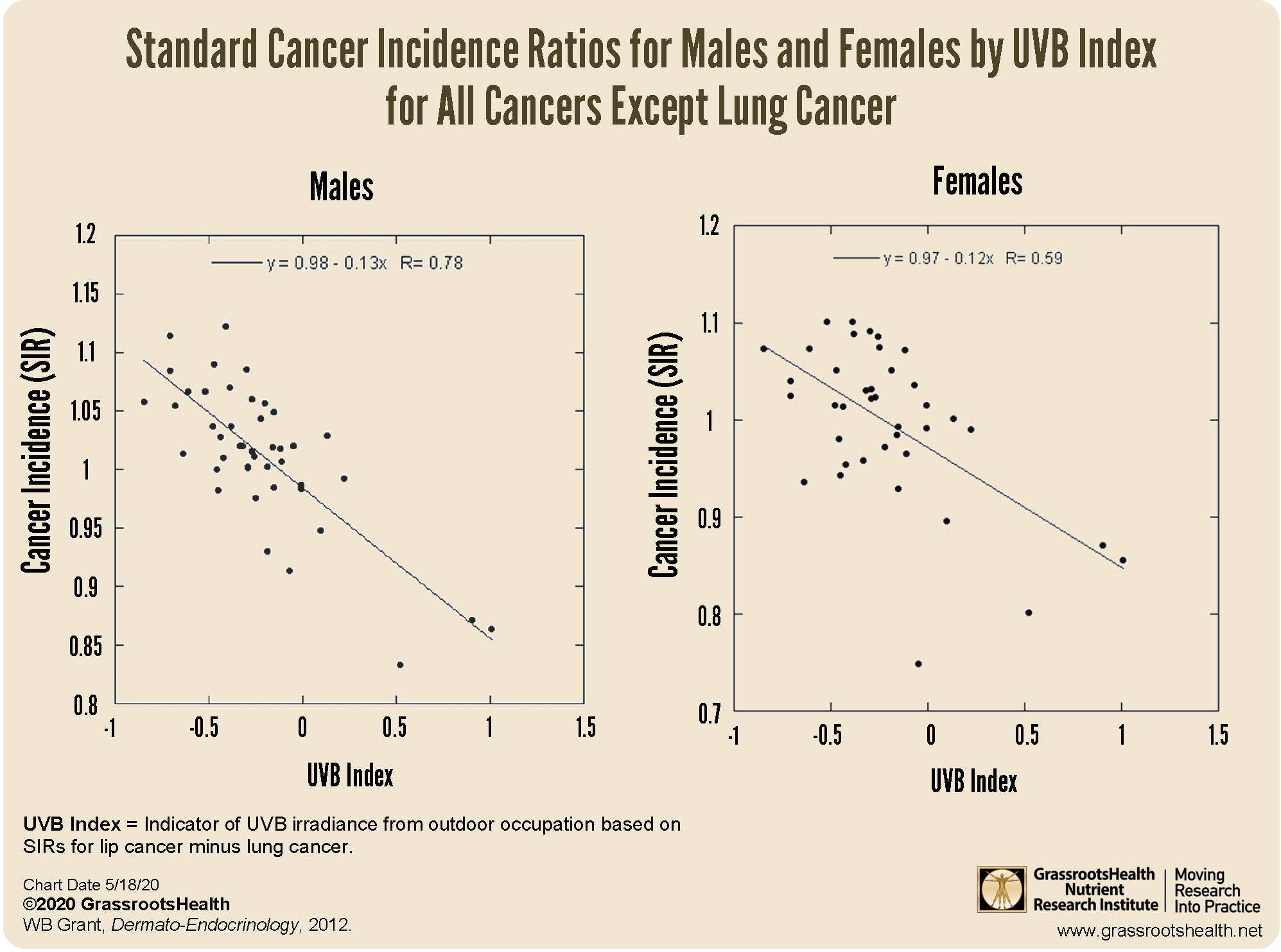Many Types of Cancer Reduced with Higher Amounts of Lifetime UVB and Sunshine Exposure

Research over the last few decades have confirmed a significant relationship between increased lifetime sunshine and UVB exposure and a decreased risk of many different types of cancer
Key Points
- Studies describing the relationship between UVB exposure, sunlight, and vitamin D on the incidence of colon, breast, ovarian, and other cancers have been published by the Garland brothers and other authors, with a recurring theme of decreased cancer risk with increased UVB and vitamin D; a study by Munoz and Grant found a significant association between increased solar radiation and and a decreased incidence of 23 different types of cancer
- A significant dose-response correlation between UV exposure and breast cancer risk was found in one study, such that women in the highest exposure groups had a 30% lower risk of breast cancer compared to women in the lowest exposure groups; overall, this study saw a negative correlation between UV exposure and breast cancer risk, especially among women over 40 years of age, and women who did not tan or who covered their arms and legs while in the sun also had a higher risk of breast cancer
- A detailed analysis of studies on sun exposure and melanoma and found that continuous, regular sun exposure was not associated with melanoma, but rather, sunburn doubled the risk of developing melanoma and intermittent, high-intensity sun exposure proposed a 61% increased risk for melanoma
Cancer is the second leading cause of death in the United States, second only to death from heart disease. In fact, 41.6% of males and 39.6% of females are estimated to develop invasive cancer from birth to death. Many studies over the last few decades have found a strong association between higher lifetime UVB and sunshine exposure and a decreased risk of cancers overall. A 2022 review by Munoz and Grant found that solar radiation was associated with a reduced incidence of 23 different types of cancer. Their study also suggested that reaching a vitamin D level of 80 ng/ml (200 nmol/L) could reduce cancer incidence by approximately 70% compared to vitamin D levels of 10 ng/ml (25 nmol/L).
Drs. Frank and Cedric Garland, both prominent figures in vitamin D and cancer research, were among the first to acknowledge the relationship between geographic location, sunshine exposure, and incidence of cancer. They, with their team of colleagues, published two now famous studies in The Lancet, a well-respected international medicine journal. Both studies showed markedly reduced incidence of colon cancer in populations with the highest intake of vitamin D and the highest serum concentrations of vitamin D. Additional studies describing the relationship between UVB exposure, sunlight, and vitamin D on the incidence of colon, breast, and ovarian cancer have also been published by the Garland brothers, with a recurring theme of decreased cancer risk with increased UVB and vitamin D.
Since then, research on the topic of sunshine exposure and cancer risk has exploded, with many new studies showing multiple health benefits to lifetime sensible sun and UVB exposure, including a decreased risk of melanoma and many other types of cancers. Several of these studies are highlighted below.
New 2024 Study Confirms Findings on the Relationship between UVB and Cancer
An ecological study published this year (2024) by Dr. William B. Grant evaluated cancer incidence by US state between the years 2016-2020 using data from the CDC’s Cancer Statistics At a Glance website. The purpose of the study was to evaluate to what extend solar UVB reduced cancer risk compared to previous findings, and to also identify new factors that might play a role in the association. The study included data only on non-Hispanic whites due to the more pronounced impact of solar UVB exposure on those with lighter skin compared to those with darker skin.
The study found that solar UVB was significantly associated with a decreased incidence of
- bladder
- brain (males)
- breast
- corpus uteri
- esophageal
- gastric
- non-Hodgkin’s lymphoma
- pancreatic
- and renal cancer
The study also found that
- diabetes was significantly associated with breast, liver, and lung cancer
- obesity was significantly associated with breast, colorectal, and renal cancer
- alcohol consumption was significantly associated with bladder and esophageal cancer
As the study concluded,
“The role of solar UVB in reducing the risk of cancer has been reduced due to people spending less time outdoors, wearing sunscreen that blocks UVB but not UVA radiation, and population increases in terms of overweight and obese individuals, which are associated with lower 25-hydroxyvitamin D concentrations and the generation of systemic inflammation, which is a risk factor for cancer… Solar UVB exposure for a few minutes before applying sunscreen and taking vitamin D supplements would also help reduce the risk of cancer.”
Dr. Grant also comments on the interesting increase in melanoma incidence, which is related to increased solar UVA exposure, not UVB exposure, which could be explained by the high use of sunscreens. Sunscreens are very effective at blocking UVB but do very little to block UVA. Because of this, it is recommended that “regular sunscreen use should be accompanied by regular vitamin D supplementation.”
Finally, the study notes that fewer cancers are now related to solar UVB doses due to the contribution of various additional risk factors, including dietary factors linked to diabetes and obesity.
Decreased Risk of Breast Cancer
Research on breast cancer and vitamin D has shown that women with vitamin D levels at or above 60 ng/ml (150 nmol/L) had an 80% lower breast cancer risk compared to women with levels below 20 ng/ml (50 nmol/L). Similar results have been found among women in the United Kingdom — an 83% lower breast cancer risk with vitamin D levels above 60 ng/ml. A 2019 meta-analysis by Song et al. analyzed data from 70 observational studies and found a 6% lower risk of developing breast cancer for every 2 ng/ml (5 nmol/L) increase in vitamin D blood levels.
Long-term UV exposure has also been associated with a lower risk of breast cancer, especially among women diagnosed in older age. A study by Pedersen et al. found that long-term occupational UV exposure was associated with a reduced risk of late-onset breast cancer among Danish women, with longer durations and higher amounts of UV exposure contributing to a further decreased risk. This study found a 17% decreased risk for late-onset cancer with longer duration of UV exposure, and an 11% decreased risk with higher cumulative UV exposure. The researchers also found a 15% decreased risk overall associated with longer duration of UV exposure for all diagnosis ages combined.
A dose-response meta-analysis on UV exposure and breast cancer risk, by Yilun Li and Li Ma, aimed to quantify the relationship between the amount of UV exposure and breast cancer risk. They included six case-control studies and conducted a dose-response meta-analysis, with an additional analysis by age, sunscreen use, and limb coverage. A significant dose-response correlation between UV exposure and breast cancer risk was found, such that women in the highest exposure groups had a 30% lower risk of breast cancer compared to women in the lowest exposure groups. Overall, this study saw a negative correlation between UV exposure and breast cancer risk, especially among women over 40 years of age; women who did not tan or who covered their arms and legs while in the sun also had a higher risk of breast cancer.
Another study by Knight et al. found the strongest breast cancer risk reduction among women with the highest amount of sun exposure and vitamin D intake during the ages of 10 to 19 years old, with a weaker association at 20 to 29 years old and no association for the oldest group. This study indicates that higher amounts of sunshine exposure and vitamin D during adolescence may help prevent the development of breast cancer later in life.
Decreased Risk of Colorectal Cancer
Rates of colorectal cancer, the third most common cancer worldwide and the second leading cause of cancer death, are higher further from the Equator across 173 countries (P<0.0001). Additionally, higher UVB irradiance was associated with lower colorectal cancer risk (P<0.0001) after adjusting for cloud cover and other relevant factors. The relationship is illustrated in the U-shaped “smiley” curve below, which shows higher disease rates in the far northern and southern latitudes – locations that have lower UVB irradiance from the sun. Countries that are closer to the Equator (presenting in the center of the horizontal axis around the 0 degree latitude) have higher UVB irradiance and tend to have lower disease rates.
Dr. Garland and his research team have also published similar results for lung and breast cancer, ovarian cancer, endometrial cancer, renal cancer, bladder cancer, pancreatic cancer, brain cancer, leukemia, and multiple myeloma.
“Colon cancer mortality rates are the highest in places where populations were exposed to the least amounts of natural light.” Dr. Cedric F. Garland
A study by Valles et al. found a 19% lower risk of colorectal cancer for participants who reported sun exposure of 2 or more hours per day compared to 1-2 hours per day in the prior summer, and that sun exposure and dietary vitamin D, both separately and together, could reduce colorectal cancer risk and be key to cancer prevention.
Decreased Risk of Gastric Cancer
A meta-analysis by Chen et al. looked at 11 different studies in total on gastric cancer to determine if there was a relationship between the incidence of gastric cancer and vitamin D intake, serum level, or solar UVB exposure. As concluded by the authors, “Increasing evidence shows that UVB radiation could be a protective factor for gastric cancer. When considered in combination with vitamin D, sunlight, and cancer, the evidence is clear that exposure to UVB radiation could afford protection against cancer.”
Decreased Cancer Risk Overall
A 2012 study by Dr. William B. Grant looked at cancer data from five Nordic countries, between 1961 and 2005, to evaluate the relationship between solar UVB and cancer rates based on 54 different occupation categories. The occupation categories were further divided into those that were primarily outdoor versus those that were primarily indoor.
Findings differed among men and women, with a decreased incidence of several different types of cancer among those with higher UVB exposure. For men, 15 different cancers were significantly inversely correlated to UVB: bladder, breast, colon, gallbladder, kidney, laryngeal, liver, lung, oral, pancreatic, pharyngeal, prostate, rectal, small intestine cancer, and melanoma. For women, UVB was significantly inversely correlated to bladder, breast, colon, and rectal cancer.
One of the most impressive studies on sunshine exposure and health outcomes by Lindqvist et al. found that the mortality rate for women who avoided sun exposure was two times higher than those with the highest sun exposure, with an intermediate mortality rate in those with moderate sun exposure. Key findings by Lindqvist et al. specific to cancer include:
- Women with active sun exposure habits had a lower risk of death from cardiovascular disease, cancer, and causes of death other than cancer or heart disease, such as diabetes, multiple sclerosis and pulmonary disease
- A 40% higher risk of cancer-related death was seen among women with low sun exposure vs the greatest sun exposure
- Women who developed melanoma but had more life-time sun exposure were more likely to survive, with mortality rates of 36% among the low sun exposure group, 16% for moderate sun exposure, and 13% for those with the greatest sun exposure
- Compared to women with the highest sun exposure, life expectancy for women who avoided sun was shorter by 0.6 to 2.1 years
“Our study showed that there was a 40% higher risk of cancer related death in the group with low sun exposure as compared to those with greatest sun exposure. This can be attributed to the production of vitamin D or other beneficial health benefits from sun exposure.” Dr. Pelle Lindqvist
Decreased Risk of Melanoma
Regular, moderate, non-burning sunshine exposure and higher levels of vitamin D are shown to decrease (not increase) the risk of melanoma. In fact, WHO’s International Agency for Research on Cancer (IARC) published a detailed analysis of studies on sun exposure and melanoma and found that continuous, regular sun exposure was not associated with melanoma, but rather, sunburn doubled the risk of developing melanoma and intermittent, high-intensity sun exposure proposed a 61% increased risk for melanoma. More specifically, painful sunburns before the age of 20 seem to be a strong predictor of all types of skin cancer, while chronic or lifetime sun exposure has been associated with an increased risk of SCC but a decreased risk of BCC and melanoma, according to Rosso et al.. More to come on this important topic in our next post.
SmartTan.com news articles regularly report medical and scientific information to keep you abreast of current events related to UV light. This information is not intended to be used by any party to make unwarranted health claims to promote sunbed usage. Indoor tanning businesses are obligated to communicate a fair and balanced message to all clients about your products and services including the potential risks associated with indoor tanning. Contact your Smart Tan representative to find out more about what you can and can’t say in your tanning salon business.
© 2024 International Smart Tan Network. All rights reserved.




